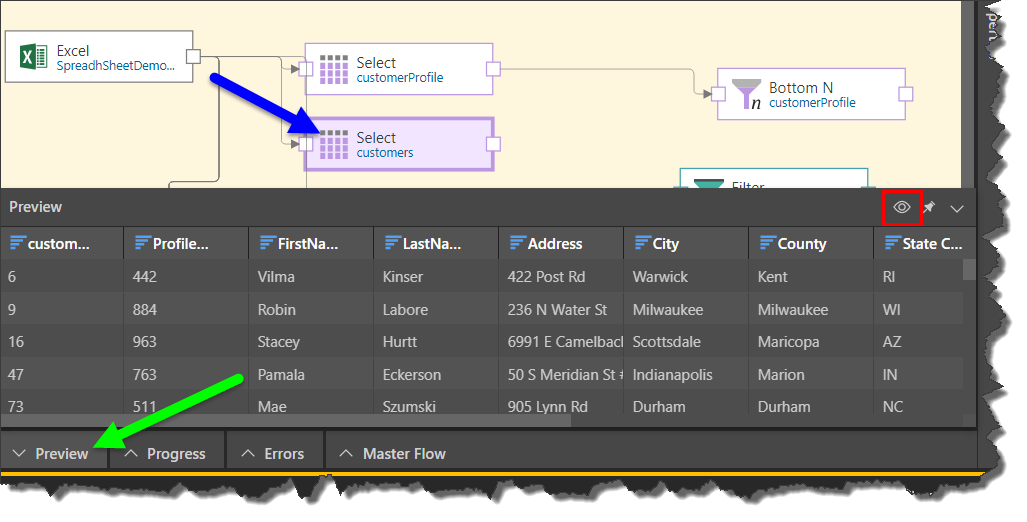Datasource Preview
You can preview a given table and access statistics about selected columns in the table. If you've manipulated the data set using any of the select, preparation, column operation, join, machine learning, or scripting nodes, you can view a preview of the table with the given operation or function applied to it.
By default, the preview is limited to 50 rows for performance reasons. If needed, you can increase the preview size but this may increase the preview loading time.
 Watch how to review statistics for the columns in a given table and take suggested actions, like adding time intelligence.
Watch how to review statistics for the columns in a given table and take suggested actions, like adding time intelligence.

Preview a Table
The preview panel can be accessed in 2 ways:
Click the Preview icon (red highlight below) from the Properties panel of the selected table node:

Or click the Preview tab (green arrow below) and select the relevant table node:

You can refresh the preview from both the Properties panel and the Preview panel by clicking the Preview icon.
Preview Size
By default, the preview displays the first 50 rows in the table. The preview size can be changed from the Data Flow ribbon; click the Preview Size drop-down and select a preset.

Alternatively, click 'Custom' to customize the preview from the Set Preview Size dialog.
Set Preview Size
Customizing the preview size is relevant if you want to set a sample fetch size that is larger than the preview size. This is useful if you've added certain nodes to the table, like filters, joins, or summarize.

For instance, you may have added the filter 'salary > $100,000' to a table. If you then preview that filtered table, and the first 50 rows did not contain the filter condition of salary above $100,000, the preview will be empty. But if you increase the sample fetch limit to 300, the system will fetch the first 300 rows in the source and return the first 50 rows where the filter condition is met.
Customize the preview size by setting the following preferences:
- Preview Size: the number of rows to be included in the preview.
- Sample Fetch Limit: the number of rows fetched from the source in order to create the preview.
- Unlimited: enable this option if you want the system to continue the sample fetch until the given number of rows meeting the condition is found. Be aware that this can be very slow.
Sort and Filter the Preview
Hover over a column header to show sorting and filtering options (red arrow below). Click the arrows once to sort the preview of the given column in alphabetical order, or twice to sort in reverse-alphabetical order. Click a third time to undo sorting.
Click the funnel icon to filter the preview of the given column.
Note: these options sort and filter the preview only.

Column Statistics
Note: this feature is not available in the Community edition.
Click a column's bar chart icon (green arrow above) to open its Column Statistics panel. In the first panel you'll see a breakdown of statistics, including the number of rows, distinct values, and blanks. For numeric columns, you'll also see the maximum, minimum, and average values. By default, the statistics displayed are based on the first 50 rows in the column. Click the drop down (red arrow below) to increase the number of rows in the preview.
In the next panel you'll see a visualization of the column's statistics. By default this is presented in a bar cart. Click the Column chart icon (green arrow below) to switch to a column chart. The chart shows information according to the column type:
String columns: a chart displaying frequency of text length, and another chart displaying frequency of values.
Numeric columns: displays a chart showing the frequency of values.
Date columns: displays a frequency distribution of the date according tot he range (i.e. year).
Under Suggested Actions, where relevant you'll see suggested actions you can take:
Replace outlier with mean: adds a node to the ETL to replace the outlier of the given column with the mean.
Remove Blanks: adds a filter node to the ETL to remove blanks from the given column.
Add Time Intelligence: adds a Time Intelligence node to the ETL to separate a given dateKey column into time intelligence columns.
